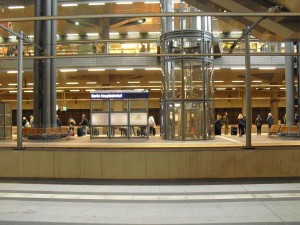All Trains Lead To Bewitching Bratislava
The food was equally pre-prepared, consisting mainly of a la carte sandwiches, pasta and, this being Central Europe, a selection of dried meats and pastries. Still, I felt obliged to play the part of a 1920s gentleman or wandering writer, and my stomach really was howling like a pack of ravenous wolves in the throes of winter’s desperation. The solution, of course, was beef goulash with bread dumplings and hot chocolate. That was more like it, and at just 6.80 euros ($9.17), was much more affordable than such a luxury had a right to be.
In addition to their gastronomic offerings, such cars are also — inevitably — the center of social life of any train. Looking around, it seemed most of my fellow travelers were either dowdy businesspeople or well-prepared youngish backpackers seemingly equipped for every climactic condition from the polar to the outright tropical. Somehow, I doubted sunscreen would be needed at our destination.
They seemed preoccupied, however, with all manner of modern gizmos. Passengers, young and old alike, were absorbed in their smartphones, tablets and iEverythings — so much for striking up a friendly conversation.
Our train was presently passing through the Western Carpathians, the forebodingness of which inspired Bram Stoker to settle on the region as the home of the titular villain in Dracula. Before they were all but completely stripped away, iron, gold and silver were found in great quantities here, so much so that after the Roman emperor Trajan’s conquest, he brought back over 165 tons of gold and 330 tons of silver.
A few mores hours passed, spent with more experiential literature and scribbling notes for my memoir about travels in a place far from my current location. My body may have been on the train, but my mind was far in the depths of the deepest parts of the Orient.
Dusk had already come and gone as we reached the train’s terminus. Bratislava hlavná stanica is Bratislava’s main railway terminal, and despite its unassuming appearance has a fair amount of history behind it. The first station building was built in 1848 as the terminus for the Vienna-Bratislava and Břeclav-Bratislava lines, but today is used as the headquarters for the local railway police. The second building, which is also unsurprisingly the most highly trafficked railway station in Slovakia, was built after the completion of the Budapest-Bratislava line in 1905 to the design of Ferenc Pfaff, the Hungarian state railway’s main architect. But it also has a darker, and certainly more obscure, secret.
The station also features one of Bratislava’s largest bomb shelters, built during the communist era to protect citizens from air raids or attacks from weapons of mass destruction. Built in the 1950s, it was designed to accommodate up to 1,500 people for extended durations. The main entrance can be found at the very end of a tunnel leading to railway platforms and, after leaving the tunnel, the entrance is behind a small metal door built into a massive rock wall. The shelter features several hallways, a command center, air filtering, power generators and toilets. It is now owned by state-run rail enterprise Railways of the Slovak Republic (Železnice Slovenskej Republiky, ŽSR for short), which allegedly plans to use it to protect its employees in case of future conflict.
But there’s no trace of impending conflict in Bratislava’s historic Old Town (Slovak: Staré Mesto), which of course is a good thing. Located in the center of the city, cobblestone streets meander lazily amidst a haphazard maze of Baroque palaces and Gothic churches, all overshadowed by the imposing Bratislava Castle, a massive rectangular building with four corner towers set atop a rocky hill that in the past has been occupied by such historical figures as the indomitable Maria Theresa. It may lack the ostentatious vistas of ball-mad Vienna — just 60 kilometers (37.3 miles) away — but beguiles visitors with a more understated charm.
Rather than an overly congested tourist trap possessed of a frenzied party scene catering to an oft-inebriated crowd that skews on the younger side (as is unfortunately the case with some Central and Eastern European capitals), there’s a certain quietness to the Old Town. That relaxed atmosphere — the sense that no one is in much of a hurry to do anything, but still has a purpose nonetheless — means it’s the ideal location for a warm night in, without the regret of having missed out on much.
Hotel Perugia is perched above the cobblestones and barely a stone’s throw from the Danube. Comprising only 14 rooms, the cozy inn is a real writer’s haunt, or a lovers’ hideaway. The equally cozy bookstore across the narrow street is merely the icing on the cake. It was just the perfect venue for that night in.
Fifty-six euros ($75.58) seemed somewhat high, but then again, such a setting as this would go for easily two or three times that amount in Paris or London. Forking over the cash, I ascended the spiral staircase to room number 24, where an oaken desk greeted me in a room with an inspiring view of the narrow alleyway below. Turning on the heat and firing up that tool of the modern writer — the laptop, of course — I put fingers to keyboard. I wryly realized it put a new twist on the Oscar Wilde saying, “I never travel without my diary. One should always have something sensational to read in the train.”
After all, there was the matter of the return journey.


